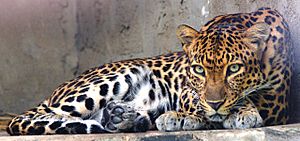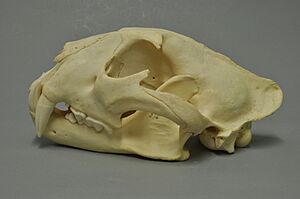Indochinese leopard facts for kids
Quick facts for kids Indochinese leopard |
|
|---|---|
 |
|
| An Indochinese leopard at Saigon Zoo and Botanical Gardens | |
| Conservation status | |
| Scientific classification |
|
| Kingdom: | Animalia |
| Phylum: | Chordata |
| Class: | Mammalia |
| Order: | Carnivora |
| Suborder: | Feliformia |
| Family: | Felidae |
| Subfamily: | Pantherinae |
| Genus: | Panthera |
| Species: | |
| Subspecies: |
P. p. delacouri
|
| Trinomial name | |
| Panthera pardus delacouri Pocock, 1930
|
|
The Indochinese leopard (Panthera pardus delacouri) is a type of leopard found in mainland Southeast Asia and southern China. These leopards are quite rare, especially outside of special protected areas. They face big threats like losing their homes due to deforestation (when forests are cut down). They are also hunted illegally for the wildlife trade.
In 2019, experts thought there were only about 77 to 766 adult Indochinese leopards left. Their numbers are still going down. Sadly, their natural living areas have shrunk by more than 90% over time.
Contents
How Was It Discovered?
The Indochinese leopard was first described in 1930 by a scientist named Reginald Innes Pocock. He studied a leopard skin from a place called Annam to identify this specific type of leopard.
What Do Indochinese Leopards Look Like?
Reginald Pocock described the Indochinese leopard's fur as a reddish-brown color, but lighter on its sides. It has small, dark spots called rosettes, which are about 3.8 by 3.8 centimeters (1.5 by 1.5 inches) big. These spots are very close together, making the leopard look quite dark. Its fur is short, less than 2.5 centimeters (1 inch) long on its back.
Interestingly, leopards living north of the Kra Isthmus (a narrow strip of land in Thailand) usually have these spotted patterns. However, south of this area, most Indochinese leopards are melanistic. This means they are completely black, like a "black panther." Black leopards are common in thick tropical forests. Their dark color helps them hide and ambush their prey.
Where Do Indochinese Leopards Live?
Today, small groups of Indochinese leopards can only be found in Myanmar, Thailand, Malaysia, Cambodia, and southern China. Sadly, they are thought to be completely gone from Laos, Vietnam, and Singapore.
The best places where these leopards still live are in Peninsular Malaysia and the Northern Tenasserim Hills along the Thailand-Myanmar border. Eastern Cambodia is also an important area for them.
In Myanmar, the number of leopards in the Chatthin Wildlife Sanctuary dropped a lot between the 1940s and 1980s. By 2000, they were almost gone from that area. However, in 2015, camera traps (special cameras that take pictures when an animal passes by) recorded leopards in the hill forests of Karen State for the first time.
In Thailand, Indochinese leopards live in large protected areas like the Western Forest Complex and Kaeng Krachan National Park. But they haven't been seen in some northern and central forest areas since the early 2000s.
In Malaysia, leopards are found in national parks such as Belum-Temengor, Taman Negara National Park, and Endau-Rompin National Park. In 2010, a spotted leopard was seen in Taman Negara, where people previously thought only black leopards lived. They have also been seen in forests that have grown back after being cut down in Selangor and Johor states.
In Laos, camera traps in the Nam Et-Phou Louey National Biodiversity Conservation Area recorded 25 different leopards between 2003 and 2004. Leopards are also reported to live in the Nam Kan National Protected Area.
In Cambodia, leopards were recorded in certain wildlife sanctuaries in 2008, 2009, and 2014. However, a study in 2021 found no leopards, suggesting they might also be gone from Cambodia.
In southern China, leopards were only found in the Changqing National Nature Reserve in the Qinling Mountains during surveys between 2002 and 2009.
What Do Indochinese Leopards Eat and Do?
Scientists have studied Indochinese leopards in Thailand to learn about their lives.
- What they eat: In northwestern Thailand, scientists collected leopard droppings (called scats) and found out what they ate. Their main food included Indian muntjac (a small deer), wild boar, and long-tailed goral (a goat-like animal). They also ate dusky leaf monkey, Malayan porcupine, and sometimes Indian hog deer.
- Where they live: In Kaeng Krachan National Park, scientists put special radio collars on three leopards. They found that male leopards used an area of about 14.6 to 18.0 square kilometers (5.6 to 6.9 square miles) as their home. A female leopard used a smaller area of about 8.8 square kilometers (3.4 square miles). They liked areas where there was a lot of prey, like near rivers and valleys.
- Home ranges: In another study in Huai Kha Khaeng Wildlife Sanctuary, ten leopards wore radio collars for many months. Adult male leopards had very large home ranges, from 35.2 to 64.6 square kilometers (13.6 to 25.0 square miles). Female leopards had the largest home ranges ever recorded in Asia, from 17.8 to 34.2 square kilometers (6.9 to 13.2 square miles). They all preferred dry evergreen and mixed forests near water.
In Malaysia, in a forest area near the city of Klang Valley, leopards mainly ate wild boar, macaque monkeys, and lesser mouse deer.
What Threats Do Indochinese Leopards Face?
There are very few large areas left where Indochinese leopards can live safely for a long time. Their biggest threats are:
- Habitat destruction: This means their homes are being destroyed, mostly because of large-scale deforestation (cutting down forests).
- Prey depletion: This means there isn't enough food for them because animals they hunt are being hunted illegally by humans.
- Illegal wildlife trade: This is a growing problem where leopards are hunted and sold illegally.
Losing Their Homes
Human activity inside protected areas can bother leopards. They are less active during the day in places where many people are present. In some villages in Laos' protected areas, local people hunt deer and wild boar for food. This hunting can reduce the number of animals available for leopards to eat.
In a forest near Malaysia's capital city, the number of leopards was surprisingly high. This might be because their forest homes are shrinking fast, pushing many leopards into the remaining small areas. Construction activities inside the forest also affect them a lot.
Illegal Hunting and Trade
A major threat is the illegal hunting of leopards for their body parts. There are markets in Myanmar, Malaysia, and China where leopard skins and bones are sold. Leopard bones are often used as a replacement for tiger bones in traditional Chinese medicine, especially as tiger parts become harder to find. This makes leopard parts more valuable. Even though there are bans on trading leopard parts, some governments still allow the use of old stockpiles of leopard bones for medicine.
In Myanmar, between 1991 and 2006, scientists found 215 body parts from at least 177 leopards in four markets. Many of these markets are near borders with China and Thailand, attracting international buyers. Even though leopards are protected by law in Myanmar, the rules are not always followed or enforced well.
Sadly, in 2018, a black leopard and other animals were found illegally hunted in Thailand's Thung Yai Naresuan Wildlife Sanctuary. This incident highlighted the serious problem of poaching.
See also
- Leopard subspecies
- Chinese leopard
- Zanzibar leopard



